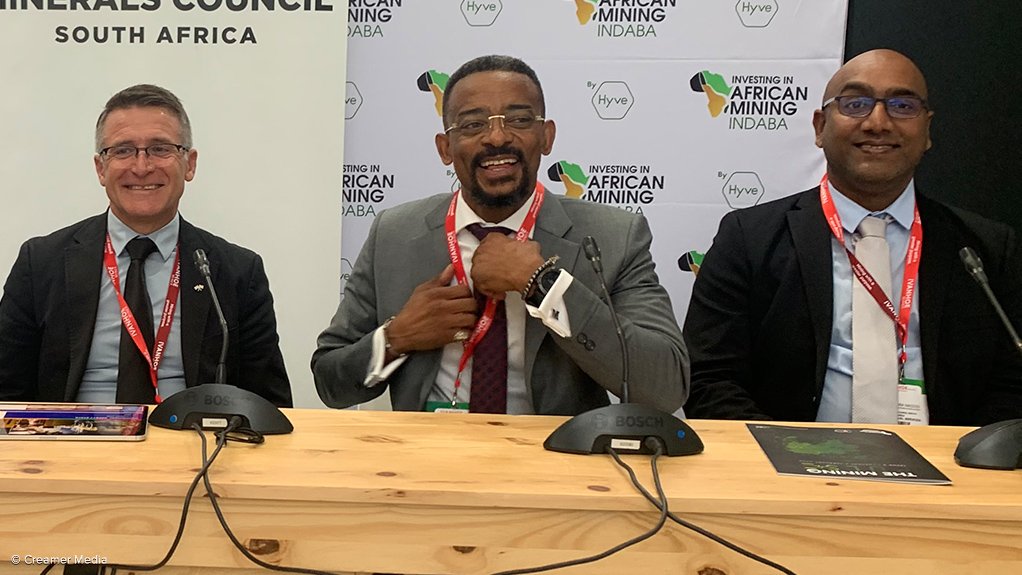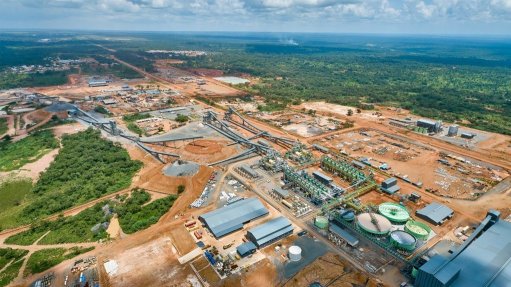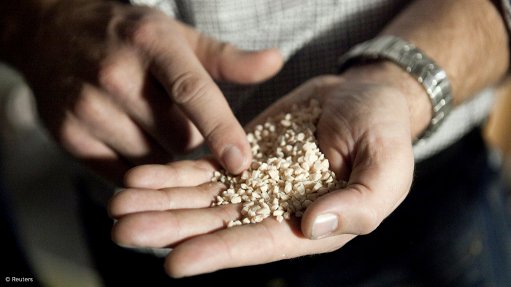Permanent aerial mesh support, exoskeletons under scrutiny to make mining safer


Minerals Council CEO Mzila Mthenjane flanked by Japie Fullard (left) and Dushendra Naidoo (right).
CAPE TOWN (miningweekly.com) – Minerals Council South Africa is looking at the possibility of promoting permanent aerial mesh support throughout the mining industry as part of its fall-of-ground action plan.
The Minerals Council has a robust fall-of-ground action plan that targets several dimensions of the biggest contributor to mining incidents.
“Many mines have adopted permanent aerial mesh support and we’re looking at further adoption,” Minerals Council head: safety and sustainable development Dushendra Naidoo said in response to Mining Weekly during a media briefing at the Investing in African Mining Indaba.
As part of the fall-of-ground action plan, the Minerals Council is also looking at the testing of exoskeletons, wearable devices designed to bolster human performance in physically demanding tasks by supporting various body parts, including the hands, lower and upper back, legs, shoulders and arms. This reduces the amount of energy required when lifting and carrying heavy objects and holding heavy tools.
While exoskeletons are already being used to help workers in a range of industrial applications globally, ranging from painting buildings to warehousing and car manufacturing, not much has been said about how they might be used in mining – one of the most dangerous and labour-intensive industries.
“That’s quite a key intervention. We’re testing quite a range of these systems to assist in the barring process. So essentially that removes a person from the unsafe rock that could potentially fall,” said Naidoo.
Barring, which is the removal of loose rocks from the walls and ceiling of an underground mine using a long steel pole, is notoriously risky work, with many fall-of-ground deaths being attributed to this process over the years.
Barring causes significant strain on the back, shoulders and arms of even the strongest and most physically fit mineworkers. This makes them unable to do the job effectively for more than a few minutes at a time, after which they become too tired to continue. This can negatively affect the barring and, consequently, put other workers in jeopardy.
Having an exoskeleton can possibly alleviate the need for barring rights close to high-risk areas.
“That’s one of the key things that we are going to be testing this year,” Naidoo said.
Eight exoskeleton systems from around the world are under scrutiny to see what the best option for South Africa’s mining industry in terms of implementation, practicality, and cost.
DRILLING FOR CLEANER BLAST
The locally developed Isidingo is viewed as a rockdrill that drills cleanly, neatly and simply. In addition, its lightness is key for adaptation for female employees to use underground.
“If you can drill cleanly, neatly and simply, you can make the blast a far more efficient process by having a cleaner blast," Naidoo pointed out.
Another key part of the fall-of-ground action plan is its rock engineering technical committee of highly skilled people who have been in the industry for many years with very heavy rock engineering expertise. They are involved in this programme and their input is key to guide the process and to look at the best way forward.
Seismic monitoring systems patented in the past that involve acoustic monitoring of the rock and tell way ahead of time what is happening ahead at the face are also under scrutiny.
In addition, cleaner-cutting systems that can mitigate the need for blasting are also being studied. These could facilitate clean excavation of rock and find application in low-profile mining.
In 2021, there were 22 fall-of-ground fatalities; in 2022, the number decreased to six and then last year, fall-of-ground fatalities doubled back up to 12.
“But if you have a look at the trend, which you must never underestimate, the hard work that the members are putting in does not bring about a quick pause and 'tomorrow things will be safe'. It doesn’t work like that," Minerals Council CEO Zero Harm Forum Japie Fullard pointed out during the media briefing.
"We’ve got a huge number of programmes. It takes much effort to arrive at a trend, to really see that we’re on the road to zero harm. It’s about behaviour, systems and all the programmes.
“If I just look at our fall-of-ground action plan and all the interventions we’ve done and how all the mining houses come together to learn and share best practice, it's good to see, it's very heart-warming. But we will not be happy with the figures until zero harm is achieved and that’s why we keep on striving towards that.
“If I have a look at all the trends over the last couple of years, seismicity and fall-of-ground incidents have come down tremendously and that’s the result of technology and all the hard work that we’ve put in. We started on this journey in 2014 and this year we will set new targets for the next ten years,” Fullard disclosed.
In 2021, mining had a significantly high number of fatalities and many interventions were embarked upon. In 2022, there was a big decrease in fall-of-ground and trackless mobile machine incidents, followed by a worsening in 2023, owing to the incident at Impala late last year.
Noteworthy is that there has been a significant holistic improvement in multi-dimensional safety, where behavior is key.
The many investments made into technology are expected to benefit the industry going forward, along with regulatory intervention.
In parallel, strong safety campaigns are being conducted and root cause analysis of incidents that could potentially have had catastrophic outcomes is a strong focus, with Minerals Council South Africa totally committed to getting its safety numbers down to zero.
Article Enquiry
Email Article
Save Article
Feedback
To advertise email advertising@creamermedia.co.za or click here
Announcements
What's On
Subscribe to improve your user experience...
Option 1 (equivalent of R125 a month):
Receive a weekly copy of Creamer Media's Engineering News & Mining Weekly magazine
(print copy for those in South Africa and e-magazine for those outside of South Africa)
Receive daily email newsletters
Access to full search results
Access archive of magazine back copies
Access to Projects in Progress
Access to ONE Research Report of your choice in PDF format
Option 2 (equivalent of R375 a month):
All benefits from Option 1
PLUS
Access to Creamer Media's Research Channel Africa for ALL Research Reports, in PDF format, on various industrial and mining sectors
including Electricity; Water; Energy Transition; Hydrogen; Roads, Rail and Ports; Coal; Gold; Platinum; Battery Metals; etc.
Already a subscriber?
Forgotten your password?
Receive weekly copy of Creamer Media's Engineering News & Mining Weekly magazine (print copy for those in South Africa and e-magazine for those outside of South Africa)
➕
Recieve daily email newsletters
➕
Access to full search results
➕
Access archive of magazine back copies
➕
Access to Projects in Progress
➕
Access to ONE Research Report of your choice in PDF format
RESEARCH CHANNEL AFRICA
R4500 (equivalent of R375 a month)
SUBSCRIBEAll benefits from Option 1
➕
Access to Creamer Media's Research Channel Africa for ALL Research Reports on various industrial and mining sectors, in PDF format, including on:
Electricity
➕
Water
➕
Energy Transition
➕
Hydrogen
➕
Roads, Rail and Ports
➕
Coal
➕
Gold
➕
Platinum
➕
Battery Metals
➕
etc.
Receive all benefits from Option 1 or Option 2 delivered to numerous people at your company
➕
Multiple User names and Passwords for simultaneous log-ins
➕
Intranet integration access to all in your organisation

















